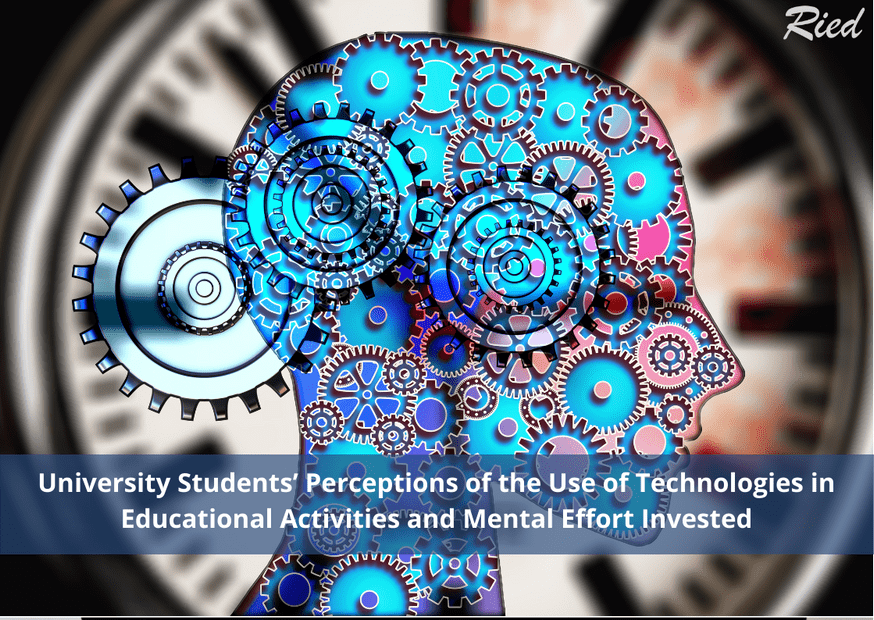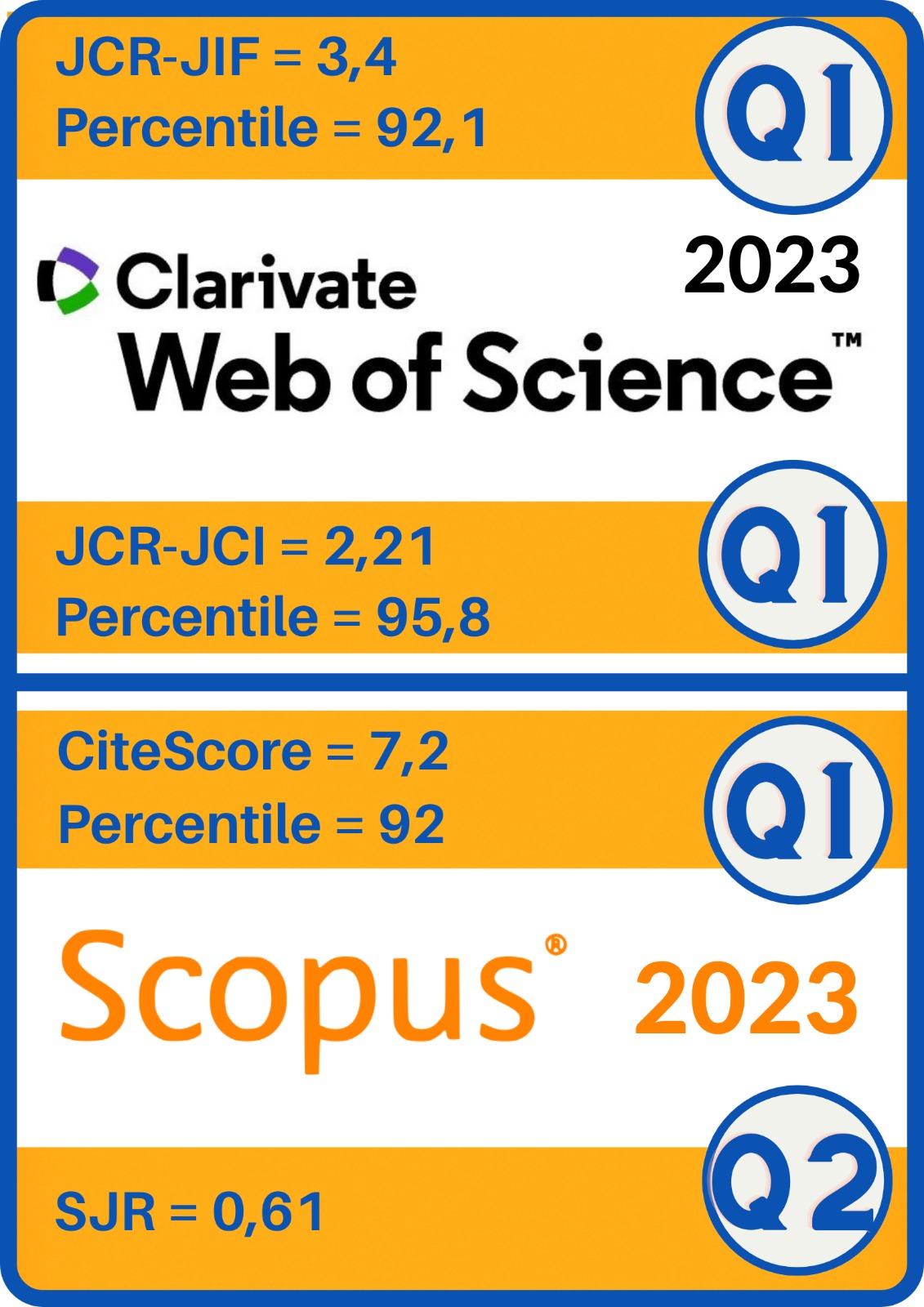University Students’ Perceptions of the Use of Technologies in Educational Activities and Mental Effort Invested
DOI:
https://doi.org/10.5944/ried.25.2.32714Palavras-chave:
technologies, school activities, students, higher education, mental effortResumo
Different generations (digital natives, resident students, generation Y, X, or Z) show a preference towards technologies and the digital world. This "ex-post-facto" study is presented to learn the preferences that university students have regarding the use of different resources for various educational activities, as well as the investment of mental effort and perceived ease of learning concerning different means and technological resources. The sampling used is non-probabilistic, conventional, and intentional. 2,148 university students from different scientific fields of twelve Spanish public universities participate in it. To do this, an "ad hoc" instrument is designed whose data show high reliability and validity indices. The results indicate that students tend to have different perceptions regarding the various means and resources presented, in terms of the level of mental effort needed, along with the degree of easiness to learn through them. In this sense, the casuistry of the results is discussed and compared with the theory of mental effort proposed by Salomon (1981). The findings can be explained by the result of the interaction of three elements: the symbolic systems mobilized to elaborate messages, the message, and the technology that packages, formalizes, and transmits them. In the same way, it concludes by discussing the applicability of the results for the improvement of the digital competence of the students.
FULL ARTICLE:
https://revistas.uned.es/index.php/ried/article/view/32714/25372
Downloads
Referências
Baron, N. S., Calixte, R. M., & Havewala, M. (2017). The persistence of print among university students: an exploratory study. Telematics and Informatics, 34(5), 590-604. https://doi.org/10.1016/j.tele.2016.11.008
Cabero-Almenara, J., Barroso-Osuna, J., & Martínez-Pérez, S. (2020). Estudiantes: ¿nativos digitales o residentes y visitantes digitales? Opción, 36(39-2), 796-820.
Cabero-Almenara, J., Duarte, A., Pérez, J., & Romero, R. (1995). Predisposiciones hacia la televisión/video y libro: su relación con algunas variables. Pixel-Bit. Revista de medios y educación, 4, 77-89.
Castellanos, A., Sánchez, C., & Calderero, J. (2017). Nuevos modelos tecnopedagógicos. Competencia digital de los alumnos universitarios. Revista Electrónica de Investigación Educativa, 19(1), 1-9. https://doi.org/10.24320/redie.2017.19.1.1148
Cohen, J. (1988). Statistical power analysis for the behavioral sciences. Erlbaum.
Colomo, E., Gabarda, V., Cívico, A., & Cuevas, N. (2020). Percepción de estudiantes sobre el uso del videoblog como recurso digital en educación superior. Pixel-Bit. Revista de medios y educación, 59, 7-25. https://doi.org/10.12795/pixelbit.74358
Creighton, Th. (2018). Digital Natives, Digital Immigrants, Digital Learners: An International Empirical Integrative Review of the Literature. ICPEL Education Leadership Review, 19(1), 132-140.
Delgado, P., Vargas, C., Ackerman, R., & Salmerón, L. (2018). Don’t throw away your printed books: A meta-analysis on the effects of reading media on reading comprehension. Educational Research Review, 25, 23-38. https://doi.org/10.1016/j.edurev.2018.09.003
Desmurget, M. (2020). La fábrica de cretinos digitales. Península
Dinno, A. (2015). Nonparametric pairwise multiple comparisons in independent groups using Dunn's test. The Stata Journal, 15(1), 292-300. https://doi.org/10.1177/1536867X1501500117
Dunlosky, J., Badali, S., Rivers, M., & Rawson, K. (2020). The Role of Effort in Understanding Educational Achievement: Objective Effort as an Explanatory Construct Versus Effort as a Student Perception. Educational Psychology Review, 32, 1163-1175. https://doi.org/10.1007/s10648-020-09577-3
Engeness, I. (2021) Developing teachers’ digital identity: towards the pedagogic design principles of digital environments to enhance students’ learning in the 21st century, European Journal of Teacher Education, 44(1), 96-114, https://doi.org/10.1080/02619768.2020.1849129
Farinosi, M., Lim, C., & Roll, J. (2016). Book or screen, pen or keyboard? A cross-cultural sociological analysis of writing and reading habits basing on Germany, Italy and the UK. Telematics and Informatics, 33(2), 410-421. https://doi.org/10.1016/j.tele.2015.09.006
Feldon, D. F., Callan, G., Juth, S., & Jeong, S. (2019). Cognitive Load as Motivational Cost. Educational Psychology Review, 31, 319-337. https://doi.org/10.1007/s10648-019-09464-6
Ferrero, E., & Cantón, I. (2020). Perception about the Influence of ICT Tools on Knowledge Management Processes in Grade of Primary Education. Píxel-Bit. Revista De Medios Y Educación, 59, 65-96. https://doi.org/10.12795/pixelbit.75070
Fortunati, L., Vincent, J., (2014). Sociological insights on the comparison of writing/reading on paper with writing/reading digitally. Telematics Inform., 31(1), 39–51. https://doi.org/10.1016/j.tele.2013.02.005
Furenes, M. I., Kucirkova, N., & Bus, A. G. (2021). A Comparison of Children’s Reading on Paper Versus Screen: A Meta-Analysis. Review of Educational Research, 91(4), 483-517. https://doi.org/10.3102/0034654321998074
Gergen, K. (1996). Realidades y relaciones: aproximación a la construcción social. Paidós.
Granada, M. (2019). Educación y exclusión digital: los falsos nativos digitales. Revista de Estudios socioeducativos, 7, 27-41. https://doi.org/10.25267/Rev_estud_socioeducativos.2019.i7.02
Hu, L., & Bentler, P. (1999). Cutoff criteria for fit indexes in covariance structure analysis: Conventional criteria versus new alternatives. Structural equation modeling: a multidisciplinary journal, 6(1), 1-55. https://doi.org/10.1080/10705519909540118
Kazanci, Z. (2015). University students’ preferences of reading from a printed paper or a digital screen – A longitudinal study. International. Journal of Culture and History, 1, 50-53. https://doi.org/10.18178/ijch.2015.1.1.009
Kutcher, M. (2018). Niños conectados. Mensajero.
Lai, K., & Hong, K. (2015). Technology use and learning characteristics of students in higher education: Do generational differences exist? British Journal of Educational Technology, 46(4), 725-738. https://doi.org/10.1111/bjet.12161
López-Cortés, F., Ravanal, E., Palma, C., & Merino, C. (2021). Niveles de representación externa de estudiantes de Educación Secundaria acerca de la división celular mitótica: una experiencia con realidad aumentada. Píxel-Bit. Revista de Medios y Educación, 62, 7-37. https://doi.org/10.12795/pixelbit.84491
López-Gil, M., & Bernal, C. (2019). El perfil del profesorado en la Sociedad Red: reflexiones sobre las competencias digitales de los y las estudiantes en Educación de la Universidad de Cádiz. International Journal of Educational Research and Innovation, 11, 83-100.
Mangen, A., Walgermo, B., & Bronnick, K. (2013). Reading linear texts on paper versus computer screen: Effects on reading comprehension. International Journal of Educational Research, 58, 61-68. https://doi.org/10.1016/j.ijer.2012.12.002
Mas, X. (2017). El tejido de Weiser. Claves, evolución y tendencias de la educación digital. OuterEDU.
Mateo, J. (2004). La investigación ex post-facto. En R. Bisquerra (Coord.), Metodología de la investigación educativa (pp. 195-203). La Muralla.
Mizrachi, D. (2015). Undergraduates’ academic reading format preferences and behaviors. Journal of Academic Libraries, 41(3), 301-311. https://doi.org/10.1016/j.acalib.2015.03.009
Paas, F., Tuovinen, J. E., van Merriënboer, J. J., & Darabi, A. A. (2005). A motivational perspective on the relation between mental effort and performance: optimizing learner involvement in instruction. Educational Technology Research and Development, 53, 25-34. https://doi.org/10.1007/BF02504795
Pálsdóttir, Á., & Einarsdóttir, S. B. (2016). Print vs. digital preferences: study material and reading behavior of students at the University of Iceland. In S. Kurbanoğlu, J. Boustany, S. Špiranec, E. Grassian, D. Mizrachi, L. Roy & T. Çakmak (Eds.), Information literacy: key to an inclusive society (pp. 228-237). Springer.
Pálsdóttir, A. (2019). Advantages and disadvantages of printed and electronic study material: Perspectives of university students. Information Research, 24(2), 828. https://doi.org/10.1007/978-3-319-52162-6_22
Parodi, G., Moreno-de-León, T., Cristóbal, J., & Burdiles, G. (2019). Generación Google o Generación Gutenberg: Hábitos y propósitos de lectura en estudiantes universitarios chileno. Comunicar, 58, 85-94. https://doi.org/10.3916/C58-2019-08
Peel, K. L. (2020). Everyday Classroom Teaching Practices for Self-Regulated Learning. Issues in Educational Research, 30(1), 260-282.
Rodríguez-Abitia, G., Martínez-Pérez, S., Ramírez-Montoya, M. S., & López-Caudana, E. (2020). Digital Gap in Universities and Challenges for Quality Education: A Diagnostic Study in Mexico and Spain. Sustainability, 12(21), 9069. https://doi.org/10.3390/su12219069
Romero-Rodríguez, L., Contreras, P., & Pérez, A. (2019). Media competencies of university professors and students. Cultura y Educación, 31(2), 326-368 https://doi.org/10.1080/11356405.2019.1597564
Salas-Rueda, R. A. (2020). Percepciones de los estudiantes sobre el uso de Facebook y Twitter en el contexto educativo por medio de la ciencia de datos y el aprendizaje automático. Píxel-Bit. Revista de Medios y Educación, 58, 91-115. https://doi.org/10.12795/pixelbit.74056
Salomon, G. (1981). Communication and Education: An Interactional Approach. Sage.
Salomon, G. (1983). The differential investment of mental effort in learning from different sources. Educational Psychologist, 18(1), 42-50. https://doi.org/10.1080/00461528309529260
Starkey, L. (2020). A Review of Research Exploring Teacher Preparation for the Digital Age. Cambridge Journal of Education, 50(1), 37-56. https://doi.org/10.1080/0305764X.2019.1625867
Valencia-Arias, A., Benjumea, M. L., Morales, D., Silva, A., & Betancur, P. (2018). Actitudes de docentes universitarios frente al uso de dispositivos móviles con fines académicos. Revista mexicana de investigación educativa, 23(78), 761-790.

Publicado
Como Citar
Edição
Secção
Licença

Este trabalho encontra-se publicado com a Licença Internacional Creative Commons Atribuição 4.0.







